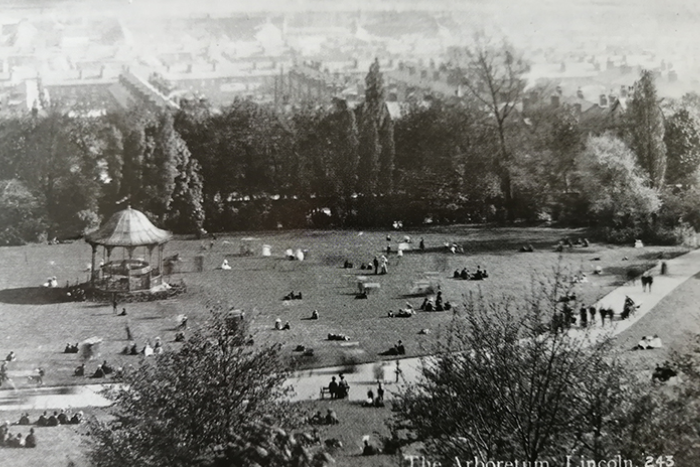
History of Lincoln’s Arboretum
The picture above shows the Arboretum on Monks Road in 1925, but the history of the park goes back over 150 years as Chris Johnson and Andrew Walker from The Survey of Lincoln report.
Public parks became a common feature of urban centres in Victorian Britain. The aim was to provide working-class people with a space in which to enjoy ‘rational recreation’, to enhance both their physical and moral wellbeing. The first urban public park was Derby Arboretum, opened in 1840.
Several sites for Lincoln’s Arboretum were considered, including land now occupied by Yarborough Road. In 1870, the Corporation obtained an Act of Parliament, the Lincoln City Commons Act, to develop the Monks Leys estate, formerly monastic land, latterly belonging to the Mainwaring family, who owned ironstone workings further east on the hillside.
In order to raise funds for the Arboretum project the Corporation sold the old sheep market, now the location of St Swithin’s Church, and attractive residential building plots next to the Arboretum, which became Lindum Terrace.
At the Arboretum’s opening in August 1872, newspaper reports described the layout of the park, the work of renowned garden designer Edward Milner. Much praise was given, especially to the long terrace dividing the upper, more formal section of the park from the lower informal part with the lion statue.
A glass pavilion was erected on the terrace, echoing the Crystal Palace, designed by Joseph Paxton, with whom Milner had previously worked. This housed many exotic plants, together with waiting rooms and a refreshment room. Throughout the park, it was noted that, for educational purposes, ‘the various shrubs and plants from foreign lands were labelled with their proper names.’ The Illustrated London News reported that, as well as the lake with its swans and ornamental fish, the lower section of the arboretum had ‘a lawn for croquet or dancing, and a maze of quickset hedges for the sportive puzzle will contribute to the pleasures of the place.’
The Arboretum’s grand opening ceremony saw visitors travelling to the city by special excursion trains from a radius of 100 miles to enjoy the event. A lengthy procession – taking 35 minutes to pass any given point – comprised various marching bands, and over 20 different types of the city’s trades, together with a Robey’s steam omnibus. The procession route from the South Common was decorated with many colourful banners and triumphal arches. One newspaper reported that the High Street was a ‘mass of gorgeousness.’
At the Arboretum, a rather curious choreographed altercation took place involving the mayor, the corporation, and 50 girls dressed as fairies. According to one report, the fairies ‘barred the way with their wands in a threatening manner.’ It was only when an extract from the 1870 Commons Act was read by the mayor that the fairies allowed access to the procession. The Arboretum crowd, estimated at 60,000, were treated later to a balloon ascent and an impressive firework display.
Somewhat surprisingly, given the ground’s principal purpose as a reputable recreational space, there was no bandstand at the Arboretum’s opening. However, in 1884, the Manchester Unity of Oddfellows, a friendly society, whose brass bands had played regularly in the park, decided to donate one. This was manufactured by cast-iron founders George Smith and Company of Glasgow. Further great ceremony accompanied its unveiling – but this time without the threatening fairies.
More can be discovered about the history of the Arboretum in The Survey of Lincoln’s booklet ‘Monks Road: Lincoln’s East End Through Time’. To discover more about The Survey of Lincoln , see www.thesurveyoflincoln.co.uk.
